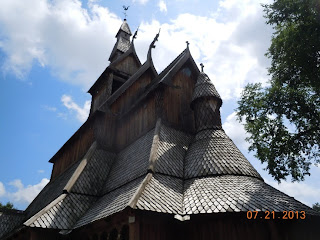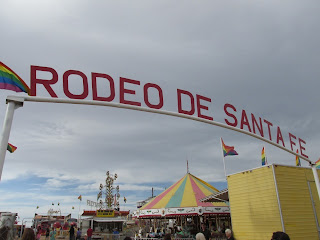Western Trips visited the Hopperstad Stave Church Replica which is a very unique building in Moorehead Minnesota, founded in 1871 and the largest town in northwest Minnesota.
 |
| Hopperstad Stave Church |
Defining a Stave Church
The definition of a stave church is a wooden medieval church structure. The method of construction gives the stave churches their name. It's elaborate columns and precise details of construction allows these buildings to last many centuries. An architectural detail all stave churches are their corner posts and framework of timber with wall planks standing on sills. Stave walls are constructed with vertical planks and their bases are in a groove on the sill beam. Their tops are in a groove on the wall plate. The entire combination of the corner posts, the verticle planks and the grooves both at top and bottom make for very solid construction.
During the Middle Ages while churches on the European continent were being built with stones, in Norway the same process was going on but the churches were constructed with wood. In fact, if you visit Norway you'll have the opportunity to visit the world's oldest wooden church, the Urnes Stave Church, which was constructed in 1150.Most of the existing stave churches are located in Norway with some also in Sweden.
 |
| Detailed roof line of church |
Construction began on the Hopperstad Stave Church Replica in Moorehead Minnesota in 1997.
The church is constructed of cedar, redwood, and pine. The church is the creation of Guy Paulson who traveled to Norway to obtain the original plans for the Urnes Stave Church. With those plans Paulson was able to calculate all his measurements and his project was launched with the aid of local architects.
Paulson who had been carving for decades was not a carver by profession. Wood carving was a hobby. Rather, he was a retired research chemical scientist in Fargo North Dakota. Guy Paulson's carvings both inside and outside of the church are absolutely magnificent.
Paulson and his family paid for building the church replica. After it's completion Paulson donated the building to the city of Moorehead Minnesota.Today, the church is used for weddings and family reunions and is open for the general public to tour.
.JPG) |
| Hopperstad Stave Church Replica |
It's an interesting note that the Hopperstad Stave Church Replica is built on the same grounds that also house a Viking ship replica that was also built by a local man. These are the grounds of the Heritage Hjemkomst Center which is a fascinating place to visit that displays excellent local artifacts and records.
Heritage Hjemkomst Center
The Heritage Hjemkomst Center, operated by the Clay County Historical Society and owned by the city of Moorehead, features photographs, recordings and an award-winning documentary that chronicles the construction of the 76-foot, hand-built Viking ship Hjemkomst. As a side note, the Clay County Historical Society is recognized as having one of the largest historical collections found in Minnesota.
The ship was built by Robert Asp and his family and is made from oak which Asp found in the area. The plan he used for construction was of the ship Gokstad which was retrieved from a clay burial mound south of Oslo Norway. A replica of this famous ship was in Chicago and it was from it that the proper measurements were taken.
Construction of the vessel began in 1974 in a warehouse in Hawley Minnesota and was christened in 1980. Robert Asp passed away about four months after the ship's maiden voyage in 1980.
The story of this Viking ship replica is absolutely amazing. After much fundraising from the community, the Hjemkomst was transported to Duluth Minnesota and eventually sailed to Oslo Norway. The Hjemkomst returned to the United States on the deck of a merchant ship.
Today, the Hjemkomst is on permanent display at the Heritage Hjemkomst Center in Moorehead Minnesota. The Heritage Hjemkomst Center also features many events throughout the year and offers rooms for rent for special occasions.
Two additional Western Trips articles you'll enjoy include...
Tall Ships
The Minnesota Massacre and the start of the Western Indian Wars
Visit the Heritage Hjemkomst Center
Visiting the Heritage Hjemkomst Center, the Viking ship Hjemkomst and the Hopperstad Stave Church Replica makes for an excellent addition to your road trip planner. Moorehead Minnesota is just across the Red River from Fargo North Dakota. Moorehead is about a 3 and one-half hour drive northwest of St. Paul Minnesota.
(Article and photos copyright 2013 Western Trips)
View Larger Map


.JPG)































